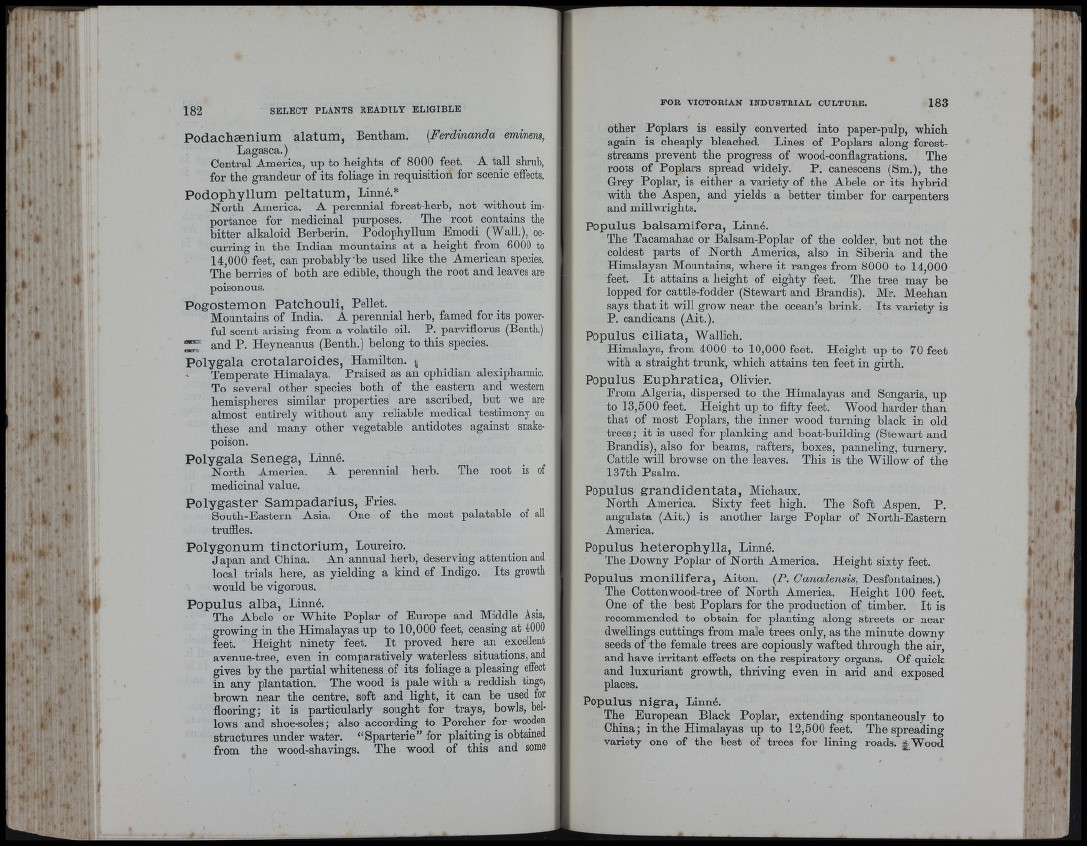
■ i • 't
»1 ■
1 • ti
Podachænium alatum, Bentham. {Ferdinanda eminens,
Lagasca.)
Central America, up to heights of 8000 feet. A tall shrub,
for the grandeur of its foliage in requisition for scenic effects.
Podophyllum peltatum, Linné.*
North America. A perennial forest-herb, not without importance
for medicinal purposes. The root contains tbe
bitter alkaloid Berberin. Podophyllum Emodi (Wall), occurring
in the Indian mountains at a height from 6000 to
14,000 feet, can probablybe used like the American species.
The berries of both are edible, though the root and leaves are
poisonous.
Pogostemon Patchouli, Pellet.
Mountains of India. A perennial herb, famed for its powerful
scent arising from a volatile oil. P. parviflorus (Bentb.)
and P. Heyneanus (Benth.) belong to this species.
Polygala crotalaroides, Hamilton. ^
Temperate Himalaya. Praised as an ophidian alexipharmic.
To several other species both of the eastern and western
hemispheres similar properties are ascribed, but we are
almost entirely without any reliable medical testimony on
these and many otber vegetable antidotes against snake-
poison.
Polygala Senega, Linné.
North America. A perennial herb. The root is of
medicmal value.
Polygaster Sampadarius, Fries.
South-Eastern Asia. One of the most palatable of all
truffles.
Polygonum tinctorium, Loureiro.
Japan and China. An annual herb, deserving attention and
local trials here, as yielding a kind of Indigo. Its growtk
would be vigorous.
Populus alba, Linné.
The Abele or White Poplar of Europe and Middle Asia,
growing in the Himalayas up to 10,000 feet, ceasing at dOOO
feet. Height ninety feet. I t proved here an excellent
avenue-tree, even in comparatively waterless situations, and
gives by tbe partial whiteness of its foliage a pleasing effect
in any plantation. Tbe wood is pale with a reddish tinge,
brown near the centre, soft and light, it can be used for
flooring; it is particularly sought for trays, bowls, bellows
and shoe-soles; also according to Porcher for wooden
structures under water. “ Sparterie” for plaiting is obtained
from the wood-shavings. The wood of this and some
other Poplars is easily converted into paper-pulp, which
again is cheaply bleached. Lines of Poplars along forest-
streams prevent the progress of wood-conflagrations. The
roots of Poplars spread widely. P. canescens (Sm.), the
Grey Poplar, is either a variety of the Abele or its hybrid
with the Aspen, and yields a better timber for carpenters
and millwrights.
Populus halsamifera, Linné.
The Tacamahac or Balsam-Poplar of the colder, but not the
coldest parts of North America, also in Siberia and the
Himalayan Mountains, where it ranges from 8000 to 14,000
feet. I t attains a height of eighty feet. The tree may be
lopped for cattle-fodder (Stewart and Brandis). Mr. Meehan
says th a t it will grow near the ocean’s brink. Its variety is
P. candicans (Ait.).
Populus Giliata, Wallich.
Himalaya, from 4000 to 10,000 feet. Height up to 70 feet
with a straight trunk, which attains ten feet in girth.
Populus Euphratica, Olivier.
Erom Algeria, dispersed to the Himalayas and Songaria, up
to 13,500 feet. Height up to fifty feet. Wood harder than
that of most Poplars, the inner wood turning black in old
trees ; it is used for planking and boat-building (Stewart and
Brandis), also for beams, rafters, boxes, panneling, turnery.
Cattle will browse on the leaves. This is the Willow of the
137th Psalm.
Populus grandidentata, Michaux.
North America. Sixty feet high. The Soft Aspen. P.
angulata (Ait.) is another large Poplar of North-Eastern
America.
Populus heterophylla, Linné.
The Downy Poplar of North America. Height sixty feet.
Populus monilifera, Aiton. (P. Canadensis, Desfontaines.)
The Cottonwood-tree of North America. Height 100 feet.
One of the best Poplars for the production of timber. I t is
recommended to obtain for planting along streets or near
dwellings cuttings from male trees only, as the minute downy
seeds of the female trees are copiously wafted through the air,
and have irritant efiects on the respiratory organs. Of quick
and luxuriant growth, thriving even in arid and exposed
places.
Populus nigra, Linné.
The European Black Poplar, extending spontaneously to
China; in the Himalayas up to 12,500 feet. The spreading
variety one of the best of trees for lining roads. 4 Wood